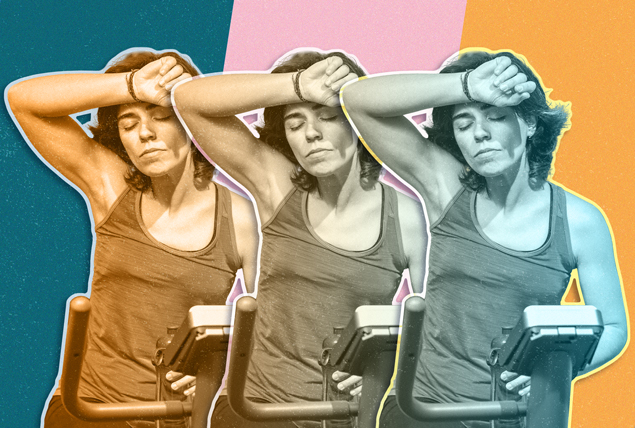Are You Working Out Too Much? Here Are the Signs of Overtraining

So much of American fitness culture promises that if you want results, you have to spend your free time working out. But can you overdo it? How can you tell it's time to cut back on your workouts, especially for women?
What does it mean to work out too much?
Kim and Khloe Kardashian often credit their two-a-day workouts for transforming their bodies and losing weight. Grueling workout programs are nothing new.
The popular 75 Hard challenge promises a new you by doing two workouts a day every day for 75 days in a row. Miss just one and you have to start all over. Of course, you'll also need to consume a gallon of water daily and skip alcohol for the duration.
Physical burnout can lead to a lack of motivation—a sign you need to change up your fitness routine or even take a break to recharge.
Engaged couples share their "shedding for the wedding" tips on social networks. That doesn't include the bride who gave her guests anti-bloat supplements. It seems as though everyone is peddling intense exercise.
How do you know if you are overtraining? When you consider celebrities and influencers, it can be difficult to distinguish between the symptoms of overtraining or enthusiasm.
What are the signs you're working out too much?
Your body will tell you when you're working out too much, according to Cara D'Orazio, a personal trainer and owner of C.G.M. Fitness Inc. in Long Island, New York. Look for the following symptoms:
- Prolonged muscle soreness
- Trouble sleeping
- Fatigue
- Fat gain
- Inflammation
- Injury
- Weakened immune system
- Decreased performance
"If you seem to be losing strength or your endurance has flatlined, it could be because your muscle fibers have been overstretched or strained," said David Mason, a qualified personal trainer and a founder of Barbells Abroad in Sheridan, Wyoming.
Physical burnout can lead to a lack of motivation. It's a sign you need to change up your fitness routine or even take a break to recharge. This is especially important if you keep getting the same injuries or discomfort, which can lead to long-term damage, Mason said.
Is recovery harder for women in the second half of their menstrual cycles?
Some people believe syncing your workout to your menstrual cycle could contribute to better overall health and athletic performance.
In the second half of the cycle, especially during the luteal and menstrual phases, women's bodies are extra sensitive to stress loads as their hormones shift, according to Bria Gadd, a Phoenix-based certified holistic health coach specializing in female hormones.
During this time, women's metabolism increases, which makes it more difficult for women to recover from workouts. It can even decrease their performance and results from workouts that require the body to change and adapt, such as anaerobic activity and weightlifting, which increase the stress levels and cortisol in the body, Gadd said.
"If there are no symptoms of overdoing it, a workout every other day is more than enough to lean out, gain muscle and feel great," Gadd added.
You don't have to literally keep up with the Kardashians.
Can overexercising hurt women's fertility and hormonal balance?
Women trying to conceive can exercise too much and hinder their chances of conception. It could result in a loss of their period, or amenorrhea. Overtraining may cause osteoporosis or bone loss in women, according to Cleveland Clinic.
What's more, too much training can affect fertility by causing a shorter luteal phase during your menstrual cycle. This shortening may result in less progesterone, an important hormone that aids in egg implantation, or when a fertilized egg attaches to the uterine lining.
There have been cases when women's periods change or stop when they are overexercising. That's why fertility clinics note strenuous workouts can decrease the success rate of in vitro fertilization, Mason said.
Hormonal imbalance can be a side effect of working out too much, according to Gadd. Being physically active and dieting could lead to relative energy deficiency in sport (RED-S). It, too, can affect your menstrual cycle.
Can women actually gain weight from overexercising?
Hitting the gym too hard and observing a crash diet can put you at risk for metabolic disruption. It's caused by excessive exercise and inadequate calorie intake. This can cause hormonal imbalances in women, a slowed-down metabolism, and a loss of energy and muscle mass.
Women entering perimenopause have a higher chance of these risks because their hormones are already naturally shifting. This can create significant hormonal chaos, according to Gadd, making one's perimenopause and menopause symptoms much worse.
Overexercising, which typically happens when women go from not working out to working out too aggressively, can increase stress hormones such as cortisol, and that can lead to weight gain around the stomach area, D'Orazio said.
Take one or two rest days a week, and make sure you're doing two different types of exercises on days you're working out twice.
There are signs and symptoms that you are hitting your training program too hard, according to Gadd. These symptoms include the following:
- Weight gain from working out too much
- Lack of energy
- Brain fog
- Moodiness
- Cravings
- Sleep disturbances
- Stiff joints
- Muscle soreness
- Increased premenstrual syndrome (PMS) symptoms
Women should try less stressful movements such as walking or yoga until these symptoms subside, Gadd advised.
So how often should women work out?
Adults can typically safely work out for at least 150 minutes a week of moderate exercise, including cardiovascular and strength training. That breaks down to about 30 minutes a day for about five days, the Physical Activity Guidelines for Americans suggested.
"It's really important for women to understand the difference between the movement for optimal health and the impact of working out on the body," Gadd said.
There is a difference. A workout doesn't need to be high-intensity or extreme to help improve your overall health.
"In fact, 60 minutes of walking each day, or 30 minutes of walking and 30 minutes of yoga, can quite comfortably burn upwards of 300 calories, which is all that is needed for the health benefits of movement," Gadd said.
Are two-a-day workouts OK for a woman's body?
"There is no evidence that working out twice a day is detrimental," D'Orazio said.
But you still need to take one or two rest days a week. You should make sure you're doing two different types of exercises on days you're working out twice.
If you notice any signs of overexercising, you should scale back your workouts immediately as this can be counterproductive and dangerous to women's health, D'Orazio added.
The biggest issue with working out twice a day is it's a difficult routine to maintain.
"If a woman stops this routine, there's always a possibility that the results achieved could diminish. When transitioning from a two-a-day, creating a plan to successfully transition from the current program will be important," said Beverly Johnson, a health coach and personal trainer based in Huntsville, Alabama.
Change up your daily exercise and focus on different muscle groups and targets such as cardio, strength or balance. It can help give your body a break and potentially help you avoid overuse injuries.
"A variety of workouts can benefit the whole body, but there is also value in quality sleep and rest," Mason said.
Do rest and recovery days affect results?
Working out every day will not get you to your fitness goals faster compared to if you build rest days into your routine.
"The bulk of the progress you make in the gym happens as you rest," said Rose McNulty, an NASM-certified personal trainer and an expert contributor for Garage Gym Reviews in New York.
Progress is owed to muscle protein synthesis, the mechanism behind strength building and muscle growth. This growth happens as a response to the damage we do to our muscles during workouts.
"If you push your muscles hard without giving them time to rebuild and recover, that's when you'll start to see signs of overtraining and likely a halt in your progress," McNulty said.
It is possible to work out too much—Listen to your body.
"I recommend three full-body workouts per week, with at least 48 hours of rest between each session. If you train at this frequency, you should take a full week of rest every eight to 10 weeks to help your body recover and avoid burnout," said Alex Legezynski, founder of West London Personal Training in London. "You won't lose any progress. In fact, you'll return stronger and less prone to injury."
That's not all. You can help avoid stress fractures, sore muscles and other effects of overtraining syndrome by taking a break.
"This approach is adopted by professional athletes and can help you maintain your results over the long term," Legezynski said.
Just because you're having a rest day doesn't mean you shouldn't still strive to be healthy.
"Rest isn't the time to hit the couch, eat junk food and stay up late on your phone," Legezynski said. "It's the time your body repairs and strengthens, so it's essential to keep it mobile and well-nourished to support that process."
It's about finding the right balance. Pay attention to your body and how you are feeling.
When you're recovering between workouts, prioritize staying hydrated.
"Hydration plays a big part in how well your muscles recover between workouts," McNulty said.
The bottom line
Yes, it is possible to work out too much. Listen to your body. You don't need to exercise daily to see weight loss or to improve your mental health. Rest days are just as important as gym days.
You are not a Kardashian, and that's OK.
Be kind to your body. Overdoing your training can lead to long-term damage. If you notice signs of overexercising, take a break to recover.


















